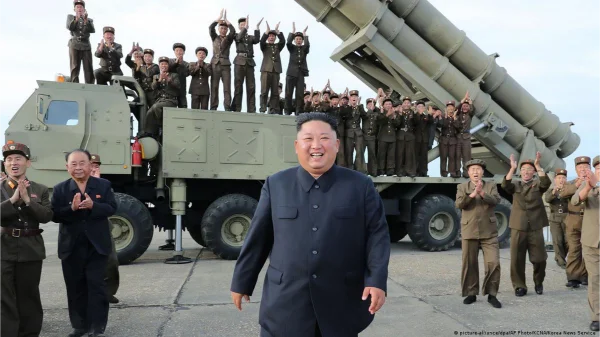Solving the problem of North Korea has been an elusive goal for the international community, with efforts ranging from military threats to peace overtures. Despite extensive sanctions, North Korea has developed a significant nuclear arsenal, including an estimated 50 warheads and advanced missile capabilities that threaten even the continental United States.
Under President Biden, the U.S. has adopted a more ambivalent stance towards North Korea compared to the direct engagement strategy of his predecessor, Donald Trump. However, experts argue that the urgency to find solutions for North Korea’s denuclearization, improving the lives of its people, and reducing conflict risks is more pressing than ever.
Warnings from analysts suggest that Kim Jong-un, North Korea’s leader, is shifting his focus away from improving relations with the U.S. and South Korea towards aligning more closely with Russia’s President Vladimir Putin, possibly preparing for conflict. Kim’s recent rhetoric has also starkly turned against the prospect of peaceful reconciliation with South Korea, threatening total domination in the event of war.
Considering these developments, it’s clear that the situation with North Korea is not just a regional issue but a significant global security challenge. The unpredictability of North Korea’s actions, paralleled with instances such as Russia’s invasion of Ukraine and sudden conflicts like that between Hamas and Israel, underscores the complexity of addressing this problem. The objective remains to find a viable path to denuclearization, improve humanitarian conditions within North Korea, and avert the devastating consequences of a potential conflict.
According to a CBS news report in January, Kim ordered his military to “thoroughly annihilate” the United States and South Korea if provoked, state media reported Monday, after he vowed to boost national defense to cope with what he called an unprecedented U.S.-led confrontation. Kim is expected to ramp up weapons tests in 2024 ahead of the U.S. presidential election in November. Many experts say he likely believes his expanded nuclear arsenal would allow him to wrest U.S. concessions if former President Donald Trump is reelected.
In a five-day major ruling party meeting in December, Kim said he will launch three more military spy satellites, produce more nuclear materials and develop attack drones this year in what observers say is an attempt to increase his leverage in future diplomacy with the U.S. South Korea’s Defense Ministry warned in response that if North Korea attempts to use nuclear weapons, South Korean and U.S. forces will punish it overwhelmingly, resulting in the end of the Kim government.
Experts say small-scale military clashes between North and South Korea could happen this year along their heavily armed border. They say North Korea is also expected to test-launch intercontinental ballistic missiles capable of reaching the mainland U.S. and other major new weapons.
An AP report noted that North Korea called the recent South Korean-U.S. military drills a plot to invade the country, as it threatened to take unspecified “responsible” military steps in response.
The North’s warning came a day after the South Korean and U.S. forces kicked off their annual computer-simulated command post training and a variety of field exercises for an 11-day run.
In a statement carried by state media, the North’s Defense Ministry said it “strongly denounces the reckless military drills of the U.S. and (South Korea) for getting more undisguised in their military threat to a sovereign state and attempt for invading it.”
In recent years, apprehension regarding North Korea’s nuclear ambitions has intensified significantly. This escalation is attributed to the nation conducting missile tests at an unprecedented frequency and its forthright threats of preemptive nuclear strikes. In response, the United States and South Korea have intensified their joint military drills and bolstered the region with formidable U.S. military capabilities, including the deployment of aircraft carriers and bombers capable of carrying nuclear weapons.
Throughout the current year, North Korea has executed a series of provocative actions, including six instances of missile tests and artillery exercises. Moreover, Kim has taken a hardline stance against South Korea, publicly renouncing any intentions of reconciliation and abandoning the longstanding objective of achieving a peaceful reunification. Kim’s rhetoric has underscored a shift towards a more hostile military strategy, particularly along the contentious maritime border with South Korea.
Analysts interpret North Korea’s accumulation of weapons as a strategy to enhance its bargaining power in eventual diplomatic engagements with the United States. There is a consensus that North Korea is eager to be internationally acknowledged as a legitimate nuclear power, a status it believes would facilitate the lifting of the punitive economic sanctions led by the U.S.
In the coming months, there are expectations of heightened tensions, with North Korea likely to increase its missile tests and adopt more aggressive rhetoric. This escalation comes as both the U.S. and South Korea have important national elections. Additionally, there is speculation that North Korea might engage in measured provocations along its heavily militarized border with South Korea, according to experts. These tensions underscore the delicate and volatile nature of inter-Korean relations and the broader regional security dynamics.
